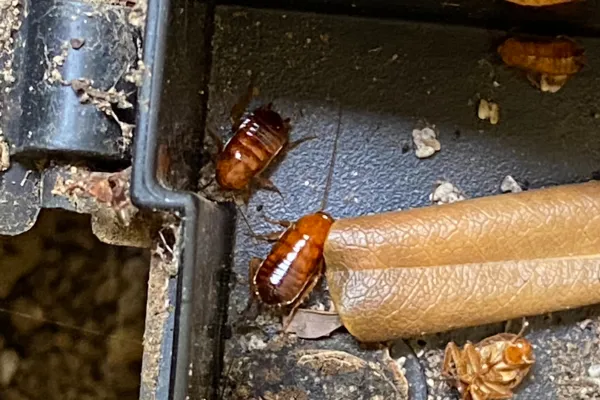
BLOGS
BLOG

The Health Risks of Roach Infestations Every Homeowner Should Know
When most people think of roaches, the first words that come to mind are “gross,” “dirty,” and “unwanted.” And they’re right — but what many homeowners don’t realize is that roaches are more than just an unpleasant sight. They’re silent carriers of disease, spreading germs, triggering allergies, and even contaminating the very air you breathe.
In the warm summer months, roaches become especially active, breeding faster and invading homes in search of food, water, and shelter. And once they settle in, they’re incredibly hard to evict.
If you’ve spotted even one roach in your kitchen or bathroom, it’s time to take the situation seriously. Let’s break down why roach infestations are a bigger health risk than you might think — and what you can do to protect your home and family.
Roaches Carry Dangerous Bacteria and Pathogens
Roaches are nature’s ultimate scavengers. They crawl through sewers, garbage bins, drains, and other filthy areas before making their way into your home. On their legs, bodies, and in their droppings, they carry bacteria like:
Salmonella – Can cause severe food poisoning, stomach cramps, diarrhea, and fever.
E. coli – Leads to gastrointestinal distress and sometimes serious illness.
Staphylococcus and Streptococcus – Harmful bacteria linked to infections.
When roaches walk across your kitchen counters, food containers, dishes, or utensils, they leave behind microscopic germs that can make your family sick.
Scary fact: Roaches have been found to carry over 30 different types of bacteria — many of which can survive on surfaces for hours or even days.
They Trigger Allergies and Asthma
For people with allergies or asthma, roaches are a nightmare. Their droppings, shed skins, and saliva contain proteins that can trigger allergic reactions and worsen respiratory problems.
Children are especially vulnerable — studies have shown that kids exposed to roach allergens are more likely to develop asthma or experience severe asthma attacks.
Signs of a roach-related allergic reaction include:
Sneezing and runny nose
Itchy, watery eyes
Skin rashes
Persistent coughing or wheezing
If someone in your household suddenly develops allergy symptoms that worsen indoors, roaches could be to blame.
Roaches Contaminate Food and Kitchen Surfaces
Roaches aren’t picky eaters. They’ll feed on anything — from leftover crumbs to pet food, and even paper or glue. Unfortunately, they often contaminate food while eating it, leaving droppings, shed skin, and germs behind.
If food packaging is damaged or left open, roaches can crawl inside, eat, and contaminate the entire package. The contamination isn’t always visible, which means you could unknowingly consume something that’s been in contact with roaches.
They Spread Parasitic Worms
While it’s not something homeowners like to think about, roaches can carry parasitic worms — including pinworms and roundworms — in their bodies and droppings. These parasites can be transmitted to humans when roach-contaminated food or surfaces are touched.
They Multiply Quickly — Making the Problem Worse
One of the most alarming facts about roaches is their rapid reproduction. A single female can produce hundreds of offspring in her lifetime. This means that what starts as a small, unnoticed problem can quickly turn into a full-blown infestation.
And the more roaches you have, the greater your exposure to their health hazards.
How to Tell If You Have a Roach Problem
Even if you haven’t seen a roach, there are signs that could point to an infestation:
Droppings that look like black pepper or coffee grounds
Unpleasant, musty odor that worsens over time
Shed skins or egg cases in hidden areas
Smear marks along walls, floors, or cabinet edges
Activity at night (roaches are nocturnal)
If you spot these signs, it’s time to take immediate action.
How to Protect Your Home and Family
While prevention is always the best approach, once roaches have entered your home, professional help is often necessary. Here are some preventive steps you can take:
Keep food sealed in airtight containers
Wipe down counters and sweep floors daily
Take out trash regularly and keep bins clean
Fix leaky faucets or pipes (roaches are drawn to moisture)
Seal cracks and crevices around walls, windows, and doors
Avoid leaving pet food out overnight
Why Does DIY Roach Control Often Fail?
Many homeowners try store-bought sprays, traps, or baits, but these solutions rarely address the full infestation. Roaches are experts at hiding in wall voids, behind appliances, and in hard-to-reach areas — places most DIY methods can’t fully reach.
Worse, using the wrong treatments can cause roaches to scatter and spread to other areas of your home.
How Valley Wide Pest Control Can Help
At Valley Wide Pest Control, we understand that roaches aren’t just a nuisance — they’re a health hazard. That’s why we use targeted, family-safe methods designed to:
Eliminate roaches at the source — including hidden nests and breeding sites.
Break the life cycle — preventing new generations from taking over your home.
Provide long-term protection — with scheduled follow-up treatments to keep your home roach-free.
Our team has a lot of experience serving homeowners in the Central Valley, and we know exactly how to deal with roach infestations — no matter how severe.
We don’t just treat the problem; we help you prevent future infestations by identifying risk factors in and around your home.
Final Thoughts
Roaches aren’t just ugly pests — they’re carriers of disease, allergens, and germs that can put your family’s health at risk. The sooner you address an infestation, the safer and healthier your home will be.
If you suspect roaches have made their way into your home, don’t wait until it’s a bigger problem.
Call Valley Wide Pest Control today for a free inspection and let us help you take back your home from these unwanted invaders.
© 2024 Valley Wide Pest Control. All rights reserved.

